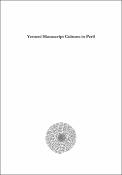Options
Toward a Reconstruction of ʿAbd Allāh b. Zayd al-ʿAnsī’s Oeuvre and Thought
Date
2022
Author(s)
F. Ansari, Hassan
Abstract
The extant works of Ḥusām al-Dīn Abū Muḥammad ʿAbd Allāh b. Zayd b. Aḥmad b. Abī l- Khayr al-ʿAnsī al-Madhḥijī (593–Shaʿbān 667/1196 or 1197–April 1269), a towering figure in seventh/thirteenth-century Yemen, illustrate the importance of the collections of manuscripts of Yemeni provenance in European libraries and the significance of the digital repatriation of this heritage, as well as the at times precarious situation of private manuscript collections in Yemen during the second half of the twentieth century. Besides al- ʿAnsī’s popular work on asceticism and morality, the K. al-Irshād ilā najāt al-ʿibād, which is preserved in countless manuscripts in the public and private libraries of Yemen as well as elsewhere (→ inventory, item 4), only a fraction of his oeuvre has come down to us. According to the later biographical tradition, this oeuvre originally comprised 105 titles.2 The Berlin State Library holds three multitext volumes containing several writings attributed to al-ʿAnsī, and for the majority of these works, the Berlin copy constitutes the only witness. All three codices are part of the collection of manuscripts that Eduard Glaser (1862–1919) sold to the State Library in February 1887: MS Glaser 79 (on which see below), MS Glaser 111 (→ inventory, items 1, 3), and MS Glaser 123 (→ inventory, items 6, 8, 10, 17). The Bavarian State Library in Munich holds two precious partial copies of al-ʿAnsī’s magnum opus in theology, al-Maḥajja al-bayḍāʾ (→ inventory, item 9), which were brought to Europe by Giuseppe Caprotti (1862–1926) and purchased by the library in 1902. These are, again, the only extant witnesses of those parts of the book. Another comprehensive work by al-ʿAnsī is his K. al-Tamyīz (→ inventory, item 20), his most detailed refutation of the Muṭarrifiyya,3 which he wrote toward the end of his life. A unique manuscript of the book was kept in the personal library of Muḥammad al-Sārī in Sanaa and at some point came to the attention of ʿAbd Allāh Muḥammad al-Ḥibshī.4 At the latter’s initiative, the codex was included among the manuscripts that were microfilmed by one of the Egyptian missions to Yemen, which took place in 1951–1952, 1964, and 1974. Since that time, the physical original has been destroyed, and all that remains is the microfilm surrogate of the book. Over the past two decades, the writings attributed to al-ʿAnsī that are preserved in European collections have increasingly come to the attention of scholars worldwide. Several refutations of the Muṭarrifiyya that are preserved in two of the Berlin codices (MSS Glaser 79, 111) have been published by ʿAbd al-Ghanī Maḥmūd ʿAbd al-ʿĀṭī in his 2002 study on the Muṭarrifiyya (→ inventory, item 3, and the discussion on MS Glaser 79 below). Al-ʿAnsī’s al-Jawāb ʿalā l-faqīh Yūsuf b. ʿAbd Allāh al-Shāfiʿī (→ inventory, item 6) and al-Sirāj al-wahhāj (→ inventory, item 17) w ere p ublished i n 2 016 a nd 2 017 ( 2nd. e d. 2 022) b y J amāl a l-Shāmī as private publications. The two Munich codices containing significant portions of al-ʿAnsī’s al- Maḥajja al-bayḍāʾ have been consulted for a number of publications, and the more complete of the two, Cod. arab. 1286, was published as facsimile with introduction and indices. 5 An edition of al-ʿAnsī’s collected epistles, currently under preparation by al-Qāsim b. al-Ḥasan al-Sarrājī, has been announced,6 and it is likely that Muḥammad b. Sharaf al-Dīn b. ʿAbd Allāh al-Ḥusaynī’s recently published Maṣādir ʿilm al-kalām al-zaydī contains further information on al-ʿAnsī’s dogmatic writings.7 A thorough analysis of al-ʿAnsī’s doctrinal thought remains, however, a desideratum, and the identity and authenticity of some of the writings that are attributed to him still need to be established. ...
Subjects
File(s)
Loading...
Name
Ansari Schmidtke_2022_Abd Allah b Zayd al-Ansi.pdf
Size
58.01 MB
Format
Adobe PDF
Checksum (MD5)
ff686d8b75a757e40a577b75c2c2df6f